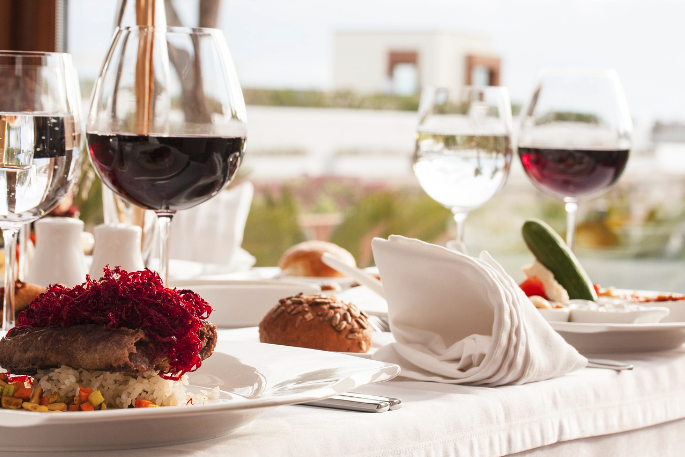How to Skillfully Co-Merchandise Food and Wine Products

When it comes to elevating the culinary experience, few combinations are as timeless and sophisticated as food and wine. As a retailer or restaurateur, co-merchandising these two elements skillfully can not only increase revenue but also create a memorable customer journey.
The food and wine business is very much like science! It encompasses a deep understanding of chemistry in winemaking, the biology of grapevines and microorganisms, the physics of storage and transportation, culinary science for pairing, economic principles in pricing and market trends, environmental considerations for sustainability, and insights from marketing and consumer behavior.
Don’t worry, in this blog post, we’ll explore strategies for co-merchandising food and wine in a proficient and competent way for mutual pleasure for customers and merchandising partners.
Becoming the Ultimate One-Stop Shop
Firstly, strive to be a one-stop shop for your customers whether they are looking to find everything they need to build an extraordinary fine-dining experience at home, assemble a delightful selection for a casual picnic, or cater to everything in between.
Offer a wide variety of wines and food items for different tastes and preferences. Certain studies show that wine buyers are also likely to shop for olives, fruit and vegetables, poultry, cooking oil, low-fat cheese, and meat.
Ensure that you have all the necessary accouterments, such as glassware, corkscrews, napkins, and serving platters, readily available. This convenience factor can make customers more likely to return to your establishment for all their food and wine needs.
Right Balance Between Perishables and Nonperishables
In the world of food and wine co-merchandising, it’s essential to consider both perishables and nonperishables. While nonperishable items like wines, sauces, and dry goods offer the advantage of a longer shelf life, perishables such as fresh products, cheeses, and charcuterie add a dynamic and ever-changing dimension to your offerings.
Successful co-merchandising involves carefully managing the inventory of both perishable and nonperishable items, ensuring that they complement each other seamlessly. This will suit a broader range of customer preferences and create a well-rounded shopping or dining experience.
Exploring Classic and Innovative Pairings
The food and wine business includes strategies for international market expansion and business communication and administration proficiency. It combines various disciplines and requires a systematic approach to achieve success and innovation.
According to a new master in food and wine business, a harmony between preserving the uniqueness of local territories and raw materials while navigating the intricacies of global market processes and management strategies is what is needed. If you want to stand out, sell homemade products that reflect the essence of both local traditions and global sophistication.
One of the keys to skillful food and wine co-merchandising is to strike a balance between classic pairings and inventive combinations. While classic pairings like red wine with steak or white wine with seafood always have their place, don’t be afraid to introduce customers to new, exciting pairings.
Consider creating displays or sections in your store or menu that highlight classic pairings and another for adventurous, unexpected combinations. Be sure to educate your customers about the reasoning behind these pairings, emphasizing how certain flavors complement each other or contrast.
Sample Delights: Encouraging Exploration
Sampling is an effective way to encourage customers to try new wines and foods. Set up tasting stations in your store or restaurant where customers can sample both wines and food items. Consider hosting regular wine and food pairing events, where customers can explore different pairings guided by knowledgeable staff.
By allowing customers to taste before they buy, you not only increase the chances of a sale but also provide an immersive experience that can enhance their understanding and appreciation of food and wine pairings.
Stress-Free Shopping Experience
Creating a stress-free shopping experience is essential for co-merchandising success. Ensure that your store layout is intuitive, with clear signage indicating where customers can find complementary food and wine items. Group products logically, such as placing wines next to related food items like cheeses or chocolates.
Provide knowledgeable staff who can assist customers in making informed choices and offer personalized recommendations. A well-trained team can make all the difference in helping customers feel confident about their selections.
Minimize Loss from Expiration
Wine and food are perishable items, so it’s crucial to manage inventory effectively to minimize loss from expiration. Implement a first-in, first-out (FIFO) system to ensure that older items are sold or used first. Regularly inspect your inventory and mark down items nearing their expiration dates to encourage sales.
Consider offering discounts on wines that pair well with foods that are nearing their expiration dates. This not only reduces potential losses but also promotes co-merchandising by encouraging customers to buy complementary items.
Wrapping up
By seamlessly integrating food and wine offerings, you have the power to elevate the entire shopping experience for your customers, turning it into a sensory journey that ignites imaginations.
You can create a winning formula that delights customers and ensures the success of your food and wine co-merchandising efforts. Skillfully co-merchandising food and wine is a fine art that can enhance the shopping experience for your customers while boosting your sales.
